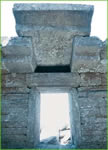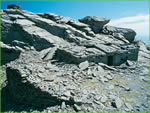Descriptions of over 20 Drakospita exist in southern Karistia, most of them in the Stiron region. The one on the top of Mount Ochi is the most significant. This ancient orthogonal structure (4.85 x 9.80m) is constructed of enormous stone blocks with no mortar. The entrance is along the length of the structure, as opposed to most ancient temples whose entrances are along the width.  The walls are so thick that you are tempted to imagine a superhuman race placing giant stones in successive layers over one another with masterful skill. The roof construction is distinctive - the so-called ‘ecphoric’. The roof slabs fit into each other internally and form a structure resembling an overturned boat. Archaeological excavations brought to light the oldest find in the area, an ancient inscription buried beneath the ground outside the structure. Numerous kiathia (cup-shaped vessels) made locally and dating back to the end of the 4th and the beginning of the 3rd centuries B.C. were found during the excavations undertaken by Professor Nikos Moutsopoulou. The walls are so thick that you are tempted to imagine a superhuman race placing giant stones in successive layers over one another with masterful skill. The roof construction is distinctive - the so-called ‘ecphoric’. The roof slabs fit into each other internally and form a structure resembling an overturned boat. Archaeological excavations brought to light the oldest find in the area, an ancient inscription buried beneath the ground outside the structure. Numerous kiathia (cup-shaped vessels) made locally and dating back to the end of the 4th and the beginning of the 3rd centuries B.C. were found during the excavations undertaken by Professor Nikos Moutsopoulou.  Other artefacts from the 5th and 4th century B.C. including attic-style vessels, glass beads, and parts of copper vessels, were also found. Inside the temple was an altar where sacrifices were made as early as the archaic period. Other artefacts from the 5th and 4th century B.C. including attic-style vessels, glass beads, and parts of copper vessels, were also found. Inside the temple was an altar where sacrifices were made as early as the archaic period.
The Drakospito of Ochi is shrouded in mystery. The archaeological evidence shows that is was a temple, a place of worship. However, the type of worship, the date of its construction and its builders remain an enigma.
It is found in an inaccessible part of the Ohi Mountain, at an altitude of 1,400 meters, which is perhaps the highest point of the mountain.
In Myli, two miles inland from Karystos, its easily found the sign to the refuge and the trail. Right next to the chappel of St. Theodoroi, the part (with indicated red walks) take us to the marble quarry (Kolones). Above the quarries was the first sign of an ancient kalderimi, which proved at higher altitude to be well preserved. The trail twisted over rock-stubbled fields of wild oregano, thyme and prickly shrubs. The dirt track take us to the Chestnut forest, one of the last remaining in Evia. Next to it, the alpine refuge (Katafygio) whre upt to 20 people can sleep. (appr. 3 hours walking to here)
|

